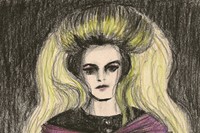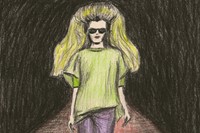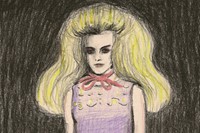The autumn collections saw fashion, and designers, in humble mode – armies of models stepped out in subtle, minimal and restrained pieces, an act of penitence during a sartorial zeitgeist that has avoided frippery and flamboyance...
The autumn collections saw fashion, and designers, in humble mode – armies of models stepped out in subtle, minimal and restrained pieces, an act of penitence during a sartorial zeitgeist that has avoided frippery and flamboyance. But we aren’t all wearing hair shirts just yet, and there were some designers who chose hubris over humility, garbing models in the colour purple.
Purple is almost unique among shades for its notably – and literally – rich history: it became the colour of the elite because of its scarcity. Dye made from crushing the shells of certain rare sea slugs was the only available method of production, and synthetic shades were difficult to manufacture well into the 18th century. So it stands to reason that purple accrued a level of metaphorical significance and symbolism beyond most other colours.
According to Greek myth, King Agamemnon was lured to his death at the hands of his wife, who encouraged him – returning as a war hero from Troy – to enter his palace on a walkway of purple cloths. Such arrogance, to tread on something so precious and near-sacred, gave Clytemnestra all the excuse she needed to stab him to death in his bath. We can only wonder what fate awaits the mild-mannered Dries Van Noten, who sent long skirts in bold, silken purple down his catwalk, where they trailed beneath models’ feet like so many tragic Greek carpets.
Once clothing became industrialised in the 19th century and purple became easier to make, it lost none of its cachet, instead becoming a symbol of fashionability. Those in the know were decked out in all shades from lilac to hyacinth to mauve, and the middle classes got in on the act as well. Such was its prominence among the young, hip and trendy that the colour became quickly associated with romantic heroines (there is a parody of one such in John Fowles’s novel The French Lieutenant’s Woman), and purple became associated with passion and seduction. Which is what Miuccia Prada referenced with her 60s-style flirty babydoll dresses in a shade known as X11 or, less bafflingly, “medium purple,” adorned with gem flowers and bows; still luxe and uptown, still girlishly playful but with an edge of modern romance.
But purple can be hard-headed too: it’s no coincidence mauvthat both Gordon Brown and Alistair Darling wore purple ties to announce their economic recovery plans in 2008. Imbued with authority, purple acts as a statement of defiance (it is also the colour associated with homosexuality, from the Victorian era, when the practice was illegal) and Preen’s slashed body-con and floral pieces for autumn were, tellingly, held together with knots, twists and slashes of Tyrian purple, the original shade worn by the Byzantine emperors and extracted from molluscs. It isn’t the first time the duo have visited the shade – their autumn/winter 2007 collection was peppered with it, with cowled dresses that struck an arcane and medieval note. It has become something of a structuring device in their deconstructed aesthetic.
And so purple has come full circle, with luxury brands creating the shade for those who can afford it (just don’t leave it on the floor and anger the gods). Meanwhile let’s not forget that purple is also linked to ostentation and pretentiousness; and there is such a thing as “purple prose,” too, which of course you will find none of in this column.
Zoë Taylor has appeared in Le Gun, Bare Bones, Ambit and Dazed & Confused. She is currently working on her third graphic novella and an exhibition.



